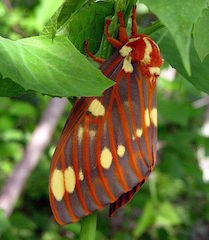OK, OK, you can bring the kids back into the room, we’re not talking that kinda horny here. The hickory horned devil is the largest caterpillar in North America. It is the larval stage of the regal moth, Citheronia regalis, and in its last instar or molt before pupating it can grow to between five and six inches long. That is five to six inches long and 3/8 inch in diameter of mean, green dangerous caterpillar-looking machine.
The hickory horned devil is fluorescent green in color. It has four long (3/8 inch) and four shorter horns – tubercles in entomology speak – protruding from just behind the head – the second and third thoracic segments to be IC (insect correct.) Shorter sharp-looking spikes protrude from the rest of the body. But all this scary armament is just for looks. Hickory horned devils aren’t venomous and don’t sting or bite – they are, in fact, quite docile. This “bluster” is said to scare potential predators. And let me tell you if those predators come in the form of 9 to 13 year-old girls it works.
My daughters were leaving for a trip to Asheville with their Mom the other day when they came rushing back into the house yelling, “come see! Daddy look at this.” I went out and I was (admittedly) not much help.
I know this could be quite a blow to my “naturalist” persona – but I had never seen such a caterpillar. I told them, in my most authoritative naturalist’s voice that – “that’s a caterpillar.” I was thinking, “whoa, that’s a big caterpillar.” So when they loaded up for Asheville I did a little research.
This regal moth wannabe spends most of its life munching the leaves of hickory, walnut, sycamore, sourwood, sassafras and other trees. In late summer/early fall these behemoth caterpillars descend those lofty heights seeking loose debris-laden soil – easy to burrow in – like the mulch at the end of our sidewalk, where they will burrow, pupate and wait out the winter.
In late spring or summer the regal moth emerges from the pupa and mate. Yep, that’s it – mate, often in a day or two after emerging. They do not even have mouthparts that function for eating – kissing, maybe? Their moth lifespan is about one week, but it’s a flashy week, the regal moth is a beauty. There are flashier moths with greater wingspans like Luna moths but the regal moth is the largest moth north of Mexico in terms of mass.
And the regal moth is not small in appearance. It has a wingspread of about five inches. The body is basically orange to bright ochre with cream-colored stripes and/or blotches. The wings have orange colored veins with the same cream-colored spots.
Regal moths are regular found clinging to our door glass and walls in the summer moths. Now that we know they emerge from vile fluorescent green horned devils, I’m sure they will have a more revered place.


